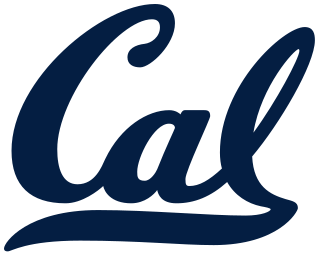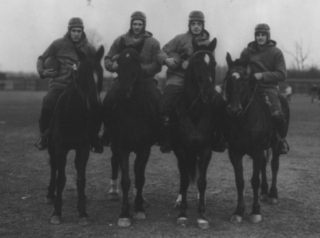Related Research Articles

The California Golden Bears football program represents the University of California, Berkeley, in college football as a member of the Pac-12 Conference at the NCAA Division I FBS level. The team plays its home games at California Memorial Stadium and is coached by Justin Wilcox. Since beginning of play in 1886, the team has won five NCAA recognized national titles - 1920, 1921, 1922, 1923, and 1937 and 14 conference championships, the last one in 2006. It has also produced what are considered to be two of the oddest and most memorable plays in college football: Roy "Wrong Way" Riegels' fumble recovery at the 1929 Rose Bowl and The Play kickoff return in the 1982 Big Game.
The 1934 college football season was the 66th season of college football in the United States. Two New Year's Day bowl games were initiated to rival the Rose Bowl Game. On February 15, Warren V. Miller and Joseph M. Cousins organized the New Orleans Mid-Winter Sports Association and by October, the group had enough funds to sponsor the Sugar Bowl. Meanwhile, W. Keith Phillips and the Greater Miami Athletic Club worked in November at a January 1 game for Florida, and the Orange Bowl was created.

The 1924 college football season was the year of the Four Horsemen as the Notre Dame team, coached by Knute Rockne, won all of its games, including the Rose Bowl, to be acclaimed as the best team in the nation. Notre Dame and Stanford were both unbeaten at season's end, with the Fighting Irish winning the Rose Bowl contest 27–10. The Penn Quakers were retroactively awarded a national championship by Parke H. Davis.
The 1934 Rose Bowl, played on January 1, 1934, was an American football bowl game. It was the 20th Rose Bowl Game. The Columbia Lions defeated the Stanford Indians 7-0. Cliff Montgomery, the Columbia quarterback, was named the Rose Bowl Player Of The Game when the award was created in 1953 and selections were made retroactively. At 35,000, it has the lowest attendance in the Rose Bowl game since the Rose Bowl Stadium was built in 1922. This was one of the few rainy New Year's Day celebrations in Pasadena, California. Rain three days before had turned the Rose Bowl stadium into a small lake.

Daniel "Sonny" Dykes is an American football coach and a former college baseball player. He is the head football coach at Southern Methodist University (SMU). Dykes previously served as an offensive analyst for TCU (2017) and as the head football coach at University of California, Berkeley for four seasons (2013–16) and Louisiana Tech University for three seasons (2010–12).
The 1940 Stanford Indians football team, nicknamed the "Wow Boys", represented Stanford University during the 1940 college football season. First-year head coach Clark Shaughnessy inherited a team that finished with a 1–7–1 record the previous season. He installed his own version of the T formation, a system that had largely fallen into disuse since the 1890s and was viewed as obsolete. The Indians shocked observers when they won all ten of their games including the Rose Bowl, which prompted several selectors to declare them the 1940 national champions. Stanford's dramatic reversal of fortunes prompted football programs across the nation to abandon the single-wing formation in favor of the new T formation.
The 1934 Alabama Crimson Tide football team represented the University of Alabama in the 1934 college football season. It was the Crimson Tide's 41st overall season and 2nd as a member of the Southeastern Conference (SEC). The team was led by head coach Frank Thomas, in his fourth year, and played their home games at Denny Stadium in Tuscaloosa, Legion Field in Birmingham and the Cramton Bowl in Montgomery, Alabama. They finished the season with a perfect record, as Southeastern Conference champions for the second consecutive season and defeated Stanford in the Rose Bowl.
The 1936 Alabama Crimson Tide football team represented the University of Alabama in the 1936 college football season. It was the Crimson Tide's 43rd overall and 4th season as a member of the Southeastern Conference (SEC). The team was led by head coach Frank Thomas, in his sixth year, and played their home games at Denny Stadium in Tuscaloosa and Legion Field in Birmingham, Alabama. They finished the season with a record of eight wins, zero losses and one tie.
The 1937 Alabama Crimson Tide football team represented the University of Alabama in the 1937 college football season. It was the Crimson Tide's 44th overall and 5th season as a member of the Southeastern Conference (SEC). The team was led by head coach Frank Thomas, in his seventh year, and played their home games at Denny Stadium in Tuscaloosa and Legion Field in Birmingham, Alabama. They finished the season with a record of nine wins and one loss, as SEC champions and with a loss against California in the 1938 Rose Bowl.

The 2010 Stanford Cardinal football team represented Stanford University in the 2010 NCAA Division I FBS football season. The Cardinal were led by head coach Jim Harbaugh, who was in his 4th and final season before leaving to become head coach of the San Francisco 49ers. Harbaugh ended his four-year tenure at Stanford having taken a team that finished 1–11 in the year prior to his arrival, to a team that ended the regular season 11–1. They played their home games at Stanford Stadium and were members of the Pacific-10 Conference.
The 1941 Stanford Indians football team represented Stanford University during the 1941 college football season. Second-year head coach Clark Shaughnessy led the team to a 6–3 record. Before the season, Stanford, which the year prior had finished 10–0, was considered a favorite for the national championship, but three conference losses put it out of contention for a return to the Rose Bowl. After the season, Shaughnessy left Stanford to take over as head coach at the University of Maryland.
The 1905 Stanford football team represented Stanford University in the 1905 college football season. In head coach James F. Lanagan's third season, Stanford went undefeated. The team played their home games at Stanford Field in Stanford, California.
The 1936 Stanford Indians football team represented Stanford University in the 1936 college football season. After winning three consecutive Pacific Coast Conference Championships the three prior seasons and the 1936 Rose Bowl on January 1, the Indians won only two games in head coach Tiny Thornhill's fourth season at Stanford. With a 2–5–2 record, Stanford lost more games in the 1936 season than in the prior three seasons combined and produced the school's worst season since the 1899 season when the Indians finished with an identical 2–5–2 record. The team played their home games at Stanford Stadium in Stanford, California.
The 1951 Stanford Indians football team represented Stanford University in the 1951 college football season. Stanford was led by first-year head coach Chuck Taylor. The team was a member of the Pacific Coast Conference and played their home games at Stanford Stadium in Stanford, California.
The 1957 Stanford Indians football team represented Stanford University in the 1957 NCAA University Division football season. The team was coached by Chuck Taylor in his seventh year as head coach. Taylor was a popular coach who had led the Indians to the 1952 Rose Bowl and who had been an All-American player for the Indians who starred on the undefeated 1940 "Wow Boys" team that won the 1941 Rose Bowl and the national championship in several polls. Just before the team's final game against archrival California, Taylor announced he was retiring as head coach to become assistant athletic director of the university.
The 1949 Stanford Indians football team represented Stanford University in the 1949 college football season. Stanford was led by fifth-year head coach Marchmont Schwartz. The team was a member of the Pacific Coast Conference and played their home games at Stanford Stadium in Stanford, California.
The 1899 California Golden Bears football team was an American football team that represented the University of California, Berkeley during the 1899 college football season. The team competed as an independent under head coach Garrett Cochran and compiled a record of 7–1–1.
The 1947 Idaho Vandals football team represented the University of Idaho in the 1947 college football season. The Vandals were led by first-year head coach Dixie Howell, and were members of the Pacific Coast Conference. Home games were played on campus in Moscow at Neale Stadium, with one game in Boise at Public School Field. The Vandals were 4–4 overall and 1–4 in conference play.

The 2019 California Golden Bears football team represented the University of California, Berkeley in the 2019 NCAA Division I FBS football season. They competed as members of the North Division of the Pac-12 Conference. In their third year under head coach Justin Wilcox, the Bears improved to an 8–5 record for only the second time since 2009, finishing 2nd in the Pac-12 North.
The history of California Golden Bears football began in 1886.
References
- ↑ "Stanford Game-by-Game Results; 1937–1941". College Football Data Warehouse. Archived from the original on 2014-10-17. Retrieved October 14, 2014.
- ↑ "Gridsters head for island tilt". The Stanford Daily. September 24, 1937. Retrieved October 14, 2014.
- 1 2 "Indian gridders sharpen axe for Columbia game; Hawaiian tilts canceled". The Stanford Daily. November 24, 1937. Retrieved October 14, 2014.
- ↑ "Stanford held to 0 to 0 tie by Columbia". Chicago Tribune. November 28, 1937. Retrieved October 14, 2014.
- ↑ "California Bears favored in vital Palo Alto battle". Eugene Register-Guard. November 19, 1937. Retrieved October 15, 2014.
- ↑ "Indians fast recovering on eastern trip". The Stanford Daily. November 22, 1937. Retrieved October 15, 2014.
- ↑ Official results from "Stanford Football Media Guide" (PDF). p. 151. Retrieved October 14, 2014.